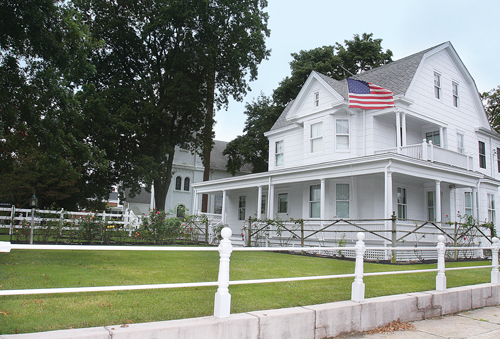National Register recognizes downtown Riverhead historic district

Back in March, a section of downtown Riverhead was approved for New York State’s Register of Historic Places.
Now, that same area has been approved for inclusion on the National Register of Historic Places, opening the door for huge tax benefits for those looking to renovate and improve old buildings.
The inclusion actually became official, quietly, on Aug. 14, according to Edson Beall, a historian with the National Parks Service, which administers the National Register.
The boundaries of the district run along Main Street, from Griffing Avenue in the west to Maple Avenue in the east, and include parts of Peconic, Roanoke, East and Maple avenues in between.
“We’re very pleased,” said Richard Wines, chairman of the town’s Historic Landmarks Commission. “We’ve been working on this for close to three years.”
Commission members plan to post signs soon alerting people of the designation, Mr. Wines said. The first one will probably be placed in front of the Methodist Church, which dates back to 1860.
Town officials also plan a press conference to announce the designation, officials said.
The oldest buildings downtown are on the grounds of East End Arts and date back to 1840, Mr. Wines said.
“It’s a pretty big district,” Mr. Beall said. “There are 46 contributing buildings that have integrity from the historic period” — meaning they’re 50 years old or older.
Mr. Beall said the area is considered significant for its commerce and architecture.
“It’s a concentration of buildings that represent Riverhead’s importance as a center of business, culture, entertainment and government on the East End of Long Island,” he said. “There’s also a large spectrum of designs, as far as architecture goes.”
The area also includes Vail-Leavitt Music Hall, which is already on the national register.
All properties considered for inclusion on the national register must first be nominated by their state, which in downtown Riverhead’s case, happened earlier this year.
In addition to the honor of the designation itself, income-producing properties on the national register also qualify for federal tax credits for rehabilitation work that meets the certifications of the register, Mr. Beall said.
The designation also offers protection from federally funded projects, he said.
“For instance, if a highway were to come through, they’d have to take the designation into account,” Mr. Beall said.
On the flip side, owners of buildings in the national register “are free to do as they please,” Mr. Beall said. “That includes tearing down the building, so long as it’s not receiving federal funding.”
The tax credits include both state and federal tax credits and can amount to up to 40 percent of the value of exterior improvements, Mr. Wines said.
“We’ve been pushing this because we think it fits right in with the Town Board’s efforts to revitalize downtown, and we think it will be nothing but a benefit,” Mr. Wines said.
The Historic Landmarks Commission is also working on a plan to get properties along Second Street — which runs parallel to Main Street — and its intersecting streets on the National Register as well, Mr. Wines said.
That area is mostly residential but includes law offices and non-residential buildings such as the former Second Street firehouse and post office, which is already on the national register individually, Mr. Wines said.
There are six individual buildings in Riverhead Town on the register. This section of downtown is Riverhead’s first national historic district, he said.








